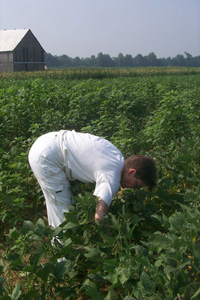Edible Soybean Project Continues to Make Inroads
Edible Soybean Project Continues to Make Inroads

Sara McNulty is a believer and she's made Sally Ellis a believer too.
The two Daviess County farmers have worked together for the past few years experimenting with edamames (edible green soybeans) as a potential crop for Kentucky producers. With the help this year of a U.S. Department of Agriculture Sustainable Agriculture Research and Education producers grant, the two are growing an acre of the beans on Ellis' Daviess County farm.
The women also have high praise for the efforts the University of Kentucky College of Agriculture has contributed to their work. The project has also had help from Iowa State University and Kentucky State University and funding in 2000 from the Kentucky Soybean Association and Kentucky Department of Agriculture.
The edamame is a horticultural crop that in the green stage can be boiled, shelled and eaten as a snack, or in salads and other dishes. The bean, like other soy products, is rich in protein, isoflavones, vitamin C and calcium.
McNulty said she had garnered all her knowledge about soy from Iowa State and marketing from UK. "They are my base," she said.
UK Extension agricultural economist Tim Woods has worked with the project for several years assisting with marketing and budget efforts. The project, including budgets and marketing information, is on the UK New Crop Opportunities Center Web site under other crops. To find the site go to the College of Agriculture's home page: www.ca.uky.edu.
"Last year, I sat down with Tim and we theoretically mapped out what we could do in the next two or three years and I did everything he told me to do," McNulty said. "And it worked out just like he said it would."
Woods said he and Extension Associate Matt Ernst have worked in developing budgeting and marketing information for the project. Initially there wasn't much budgetary information to go on, he said, but thanks to McNulty and Ellis, the information has been developed. Ernst has just returned from a meeting in Washington state where the Kentucky edamame project was showcased.
"It's one of those interesting novel crops," Woods said.
And it's one with tremendous potential.
The potential is especially strong in the fresh market but there's also good potential in the frozen market, he said. Initially, the budgets estimated a $300 return per acre. But if the post harvest issues can be worked out, the beans could provide an income of $1,500 to $1,800 per acre.
With the information garnered from McNulty and Ellis' work, Woods said they are getting to the point where they could comfortably accommodate several producers.
"We have the production logistics, better figures, varieties and have worked on handling, packing and distribution," he said.
McNulty began working with the beans four years ago and believes in their health value as well as for their opportunity to add another crop for Kentucky farmers. She's been taking the beans to area farmers markets and giving them away so people can have a taste.
The beans can be found in stores in the frozen foods and sometimes in the fresh produce areas in larger cities. The lack of consumer knowledge about the beans is one of the biggest challenges, said Sally Ellis.
Another challenge is educating produce managers and buyers that the beans need to be sold when they are green and not beginning to yellow and sour, McNulty said That can quickly turn consumers away from the beans, she said.
"We learned last year we could get them to the wholesaler but the key is timing, and once they get them to get the beans on out to the store," she said. "They will only last a week."
This year, the project is focusing on getting consumers to try them.
"What we are trying to do is just get them out to the regular person rather than the rich clientele or health food buyers," McNulty said. "We want to see how mainstreamed it can go. If we keep it too niche, health wise not enough people will benefit from it. But if we get it too mainstream, the price will go down and the farmer won't make anything."
To help spread the word, McNulty worked with Martha Lee, Daviess County Extension agent for family and consumer sciences, on a nutritional pamphlet and quick and easy recipes using the beans. They also solicited the help of UK nutritionists Janet Tietyen and Sandra Bastin.
During a training for school food service workers, about 190 attended a segment on cooking with edamames presented by Lee.
"It was a good opportunity to encourage them to use a new product," Lee said.
Ellis said she is aware of other produce growers who would be interested in growing the edamames if a consistent market can be found. She said within a few years she'd like to see quite a bit of the beans grown in the area and believes the farmer interest would be there to support the acreage.
Next year, McNulty and Ellis are looking to add some workshops to their list of chores. The workshops would focus on how to market a niche item and what it takes to grow them.
Both Ellis and McNulty believe the beans will ultimately be a success.
"I've had people who last year were laughing at me, this year are interested," Ellis said.
